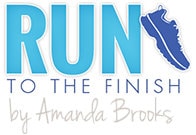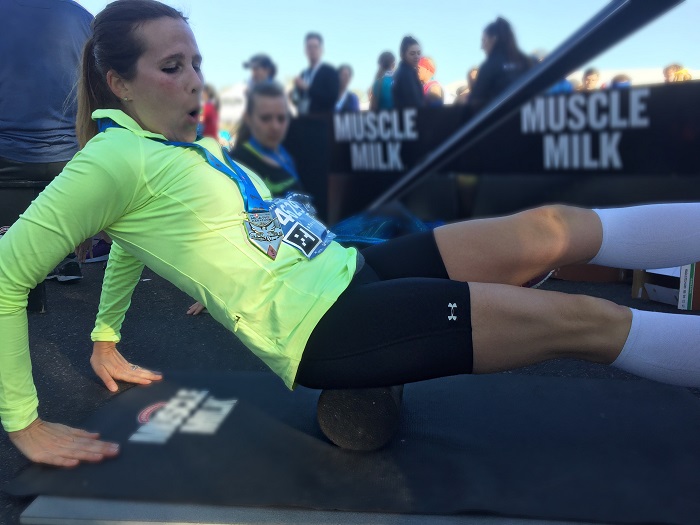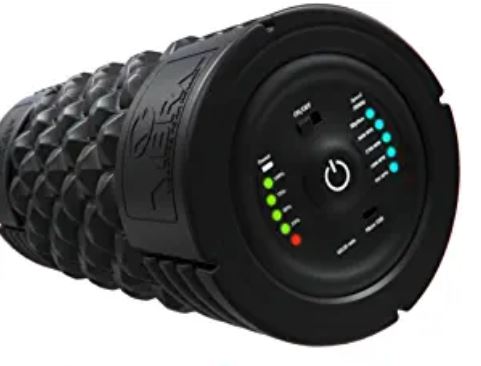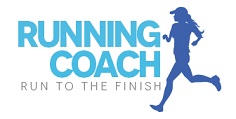Foam rollers for runners all have the same basic structure, but they’re not all made the same. If you’re an athlete, especially a runner, you’re probably looking for ways to adequately recover after a training session to be able to take on the next challenge!
When it comes to foam rolling, it’s a pain most runners know all too well now…the pain that you first avoid, then slowly find yourself craving.
Foam rolling, it’s just like running! But the best foam roller for runners may not be the same across the board.
In this article, you’ll learn everything there is to foam rolling, including what to consider when buying one. I’ve also shared the top picks that I recommend.
What is a Foam Rolling?
Foam rolling is a technique of self-myofascial release (SMR), or self massage, that helps to lengthen the fascia that covers our muscles. When restricted, the fascia create tightness that can cause muscle soreness, cramps, knots, and adhesions.
And so, a foam roller can be a versatile tool to add to your routine before or after a workout. It helps loosen up your muscles by using your body weight to release tension in the soft tissue throughout your body.
It provides a deep tissue massage that any runner would appreciate. There are different types of foam rollers on the market ranging in different densities, textures, and sizes.
The bigger sizes allow you to target larger muscle groups, such as the calves, hamstrings, and quads with ease. Foam rollers are versatile enough to target many different parts of your body, all the way from your back and shoulders to your hips.
Benefits of Foam Rolling
This type of deep tissue massage comes with a ton of benefits, including:
- Helping ease muscle pain by reducing delayed-onset muscle soreness (DOMS)
- Improving mobility by increasing joint range of motion
- Increasing blood flow and circulation, which can reduce inflammation and lead to faster recovery time
- Improving flexibility, by restoring elasticity and function to soft tissue
- Reversing muscle imbalances by alleviating muscle adhesions and knots
Is Foam Rolling Good for Runners?
That’s a question I’ve answered in depth with tips on how to foam roll to relieve IT Band pain, along with tips on hitting all the other major areas…suffice it to say, YES. Foam rolling when done correctly is great for runners.
Today we’re focusing on what foam roller do I need? Which is a bit like running shoes for me, I need them all. These photos, yup that’s my mile of current rollers…and it’s not everything because I have other recovery tools like a massage gun too.
I don’t collect knickknacks, don’t have painting on the wall, but I can rival a PT’s office. ha!
From the original black foam roller we found in physical therapist offices to new fancy versions, like all of our gear, it’s continued to evolve.
Not interested in all the research and just want an answer ASAP.
✅This is the foam roller I’d buy first.
Cheap, does the job and is super basic if you’ve never subjected your body to foam rolling.
Since they run the gamut from $10 to $120, I wanted to know what was really worth it and how my body felt using each one.
How to Use a Foam Roller?
Foam rollers can change your life if you do it the right way. It can be used on the front, back, and sides of the legs to improve blood flow, and increase range of motion and flexibility while reducing muscle soreness.
To use a foam roller, position it beneath the affected area you’re targeting and move over it slowly. As the roller moves, stop at tight points and spend some extra time there.
The only area that’s generally recommended that you should avoid is your knees. It can be used in most other areas of your body, including the arches of the feet to provide release after a run.
Read my complete foam rolling guide for runners with demo video >>
Things to Consider When Picking a Foam Roller
Now all foam rollers are made for the same purpose. You’ll find different foam rollers on the market that have different features. Here are the four things to keep in mind when picking the right foam roller for you:
#1 Firmness
The firmness of the foam roller is one of the factors that will determine the level of intensity of your foam rolling session. The firmer a foam roller is, the deeper it’ll activate your deep tissues. Softer foam rollers are best for when you’re just starting off but pick a firmer one when you want to take it up a notch.
#2 Texture
The other factor that will determine the intensity is the texture of your foam roller. A perfectly smooth roller will feel a lot more gentle than one with deep ridges.
If you’re looking for deep tissue and muscle massage with myofascial release, you’ll want to go for a foam roller that’s firm and has a bumpier texture.
#3 Portability
Foam rollers come in different sizes some smaller 12-inch ones, to longer 36-inch ones. I recommend picking a size depending on whether or not you intend on taking it out with you. You can also buy a collapsible foam roller to make it more portable.
#4 Extra Features
Many foam rollers now come with added features such as different vibration settings as well as added heat for an added level of muscle activation. You’ll see below that vibration can be very good for dealing with pain or helping to work in to a muscle.
Things like heat can also help to relax muscles.
8 Best Foam Rollers for Runners
Let’s dive in to the top picks in each area to help you find what you need to recover like a champ.
Best Overall Foam Roller for Runners
TriggerPoint GRID Foam Roller ($34)
I mention the Trigger Point by brand because it is one of the most commonly carried in running stores and recognizable with its bright orange patterned surface leaving some to wonder if it’s different from the regular foam roller. It is!
The multi-density exterior foam of the TriggerPoint GRID covers a hollow, rigid core that helps it retain its shape even when used very regularly.
There are three different surface textures on the GRID designed to mimic a massage therapist’s hand. Each serves a very specific purpose. Let’s look at what these are:
- High and firm squares: These are on each end and in the middle of the foam roller which works the muscle tissues like the fingertips.
- Long tubes: The tubular design runs in rows around the TriggerPoint GRID which acts like fingers to provide more contact when rolling.
- Low flat patches: Flat zones are meant to mimic the palms of a therapist’s hand to provide maximum surface area while rolling.
As you can see, the density and cross-hatching marks allow it to get much deeper in the tissue.
I don’t recommend this as your first foam roller, but over time it’s a great tool and one that actually sits in our living room for us both to use daily.
Best Standard Foam Roller for Runners
Go Fit Pro Massage Foam Roller – 24 inches ($30)
Amazon Basic 36inch High Density Foam Roller ($21)
We have a couple of what you’d call “standard” foam rollers in different lengths….because yes I have far too man recovery tools. But also because length and feel are things to consider in your pick.
Things you need to know:
- Using a foam roller daily it will slowly breakdown, like the cushion in your running shoes (higher density rollers last longer)
- I think it’s perfection to have multiple for different uses
- We keep one in the living room and both use it every single day because it relaxes our back after sitting at a desk all day
- We keep another where I do my daily dynamic warm up and where we lift weights
Do You Need a Short or a Long Foam Roller?
I love the longer ones because you can lay on it and spread your arms out to the side which opens up the chest, after it gets tight working on a computer all day. This is going to help improve your breathing on the run!
You’re going to have all the same benefits as a short roller, but with some added movements you can do on it like chest opening or even some core workouts.
The short roller obviously takes up less space and maybe you’ll find it easier to maneuver, but if you only want one…go long.
What is Foam Roller Density?
Foam roller density refers to how hard it’s going to feel. In other words, it will have less give and therefore feel like it’s digging in to your muscles deeper.
I like a high density foam roller 90% of the time. It’s what we need to actually get the job done of working through that fascia and sending the signal to our brain to release the muscle tension.
BUT, someone like my Dad does better with a roller like this that is slightly softer which is also the kinds of rollers you’ll usually see at Target or Wal-Mart. If you’re just starting out or working through an injury that might be a better bet for you as well!
Starting out with a softer roller means you will actually use it because it doesn’t hurt so bad and simply doing it is better than having a roller that never gets used!
Just remember these rollers break down faster and if it’s too soft you aren’t actually working anything. Plan to use it for a year and then upgrade to a higher density foam roller.
Best Vibrating Foam Roller
Trigger Point Grid Vibe Plus ($98)
I really am a fan of Trigger Point products. They last.
I’ve had my grid roller and PT balls for years and years. Even with daily use, they have maintained their firmness, unlike the above standard foam rollers which can break down.
HyperIce is the most well known name in this space. It’s also the priciest at $199. Having reviewed them alongside other massage guns, it’s definitely a great product, but honestly all of these rollers are very similar and for half the price I’m impressed with the Fitindex Vibrating Roller ($59).
Do You Need a Vibrating Foam Roller?
Need is a strong word. Want, probably because it’s fun and we’ve already discussed my love of all things pre-hab to keep me running injury free.
Brands report that the vibration helps to break up the fascia even further. I think this is partially because the vibration distracts the muscle and allows you to stay on a spot longer to work in to the tightened area.
- I do love the vibration for warming muscles up PRIOR to a workout.
- I don’t in general like it when people roll immediately after a workout because they don’t stay on spots long enough or are simply rubbing inflamed muscles.
- Whole Body Vibration has been shown to increase blood flow, which does help with muscle recovery. Does this apply to just vibration in a specific area, the science is still out.
- We know that the vibration helps to stop pain signals, which could mean you tolerate this better than a standard foam roller.
Best Massage Stick for Runners
TheStick Travel Stick ($27)
The Massage Stick was actually one of the first tools I was introduced to during my marathon training in 2005…yikes it’s been so long!
No one was foam rolling back then, but we were carrying around sticks even when the airports started asking if they were weapons.
I LOVE the stick for working on tight calves and inner thighs {checkout a few tips on this around 4 min}. However, it doesn’t let me get my shoulders, sides and back the way I can with the foam roller…yup just another reason we have so many “tools” in our house to keep me running straight.
For me it’s on the best foam roller for runners list because it might actually serve your better than a roller which isn’t portable or doesn’t hit your key spots.
Massage Stick vs Foam Rollers
Both massage sticks and foam rollers can be incredible for recovery, but they’re both used differently.
A massage stick is smaller than a foam roller and resembles a rolling pin. It consists of a bar with one-inch rollers attached to it which allows it to move easily over the body.
Massage sticks are usually also able to flex slightly, allowing them to better fit the shape of the body.
When it comes to myofascial release, both massage sticks and foam rollers provide similar results but the method to use them differs. Unlike a foam roller that you roll on top of, the stick must be pushed into the muscle with your hands.
This means you’ll use using your arms instead of your body weight to use the massage stick.
A massage stick is usually used on the leg muscles, but it works well on smaller areas like the neck and upper back as well. It’s available in a variety of lengths and is small enough to travel with.
Best Massage Balls for Runners
I know this was supposed to be about the best foam roller for runners, but I believe these count. They serve the same purpose, they just happen to be smaller.
Yoga tune up balls were the start of this new trend, which are now pretty standard tools for anyone looking to get in deeper on a knot. I actually have a variety of these balls:
- the small Trigger Point ball for digging in to my glutes and great for those with plantar fasciitis
- the larger Trigger Point ball for rolling my abdomen (read why)
- a double ball (often called a peanut) for shoulders and neck
I’ve heard a lot of people say just use a lacrosse ball, but honestly I don’t know anyone who has one of those so I might as well buy one of these durable one’s to roll around my living room.
These balls are going to get much deeper, so be prepared to hold yourself up to reduce pressure as you get used to it and of course they too are much easier for traveling.
Another one that I’m often asked about is the R8 Roll Recovery, which you can see I did a full review on and personally don’t recommend…hence the reason it’s not on this list of best foam rollers for runners!
This was a TON of information on the best foam roller for runners. I hope you are now ready to grab one and get to work on those muscles!
Looking for more reviews to find the best things for you run?
Checkout our full page of my must have running gear reviews and guides to save you time searching and money! I share what’s worked for me and fellow runners, along with what wasn’t worth the price tag.
A few common requests:
- Affordable massage guns for runners
- Best HR monitors (from watches to straps)
- Best running socks (lightweight to compression)
- Best sunglasses for running
Other ways to connect with Amanda
Instagram Daily Fun: RunToTheFinish
Facebook Community Chatter: RunToTheFinish
Sign Up to Receive a Weekly Newsletter with Top Running Tips and Laughs






 Nike Wildhorse 7 Shoe Review: Comparing Trail Running Shoes
Nike Wildhorse 7 Shoe Review: Comparing Trail Running Shoes

Pedro Esparza
Very good information Amanda I have been using a lower density foam roller for years and never
really gave it much though, but you are correct that it no longer has the same effectiveness. Reading
your blog made it an easy choice for me to upgrade to a trigger point foam roller. I am not sure if the
vibrating foam roller is for me, but maybe one day I will make the jump. Keep up the good work.